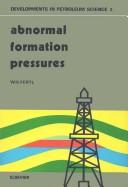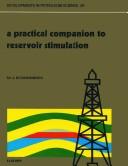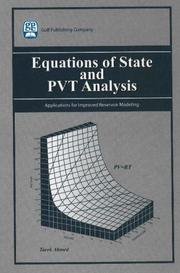| Listing 1 - 10 of 13 | << page >> |
Sort by
|
Book
ISBN: 3030828379 3030828360 Year: 2022 Publisher: Cham, Switzerland : Springer,
Abstract | Keywords | Export | Availability | Bookmark
 Loading...
Loading...Choose an application
- Reference Manager
- EndNote
- RefWorks (Direct export to RefWorks)
Multi
ISBN: 9780444899996 0444899995 9780080868967 0080868967 1282167855 9781282167858 9786612167850 6612167858 Year: 1994 Publisher: New York Elsevier
Abstract | Keywords | Export | Availability | Bookmark
 Loading...
Loading...Choose an application
- Reference Manager
- EndNote
- RefWorks (Direct export to RefWorks)
When Fertl's first book, Abnormal Formation Pressures, was published by Elsevier in 1976, the topic was relatively new in book form. In the years that followed, his book became the standard work for petroleum engineers and drillers. The list of major petroleum provinces with abnormally high pore pressures has grown steadily over the years, and with it has grown our knowledge and experience. There have also been technological advances. A new book was required, but no longer could the topic be covered adequately by one person. The problems of abnormally high formation pressures encount

ISBN: 9780444413284 0444413286 9780080868561 0080868568 1281772151 9781281772152 9786611772154 6611772154 Year: 1976 Publisher: New York Elsevier Scientific Pub. Co
Abstract | Keywords | Export | Availability | Bookmark
 Loading...
Loading...Choose an application
- Reference Manager
- EndNote
- RefWorks (Direct export to RefWorks)
Abnormal Formation Pressures
Reservoir oil pressure. --- Oil well drilling. --- Gas well drilling.
Book
ISBN: 1009031228 1108151728 Year: 2021 Publisher: Cambridge, United Kingdom ; New York, NY, USA : Cambridge University Press,
Abstract | Keywords | Export | Availability | Bookmark
 Loading...
Loading...Choose an application
- Reference Manager
- EndNote
- RefWorks (Direct export to RefWorks)
Geopressure, or excess pore pressure in subsurface rock formations that is higher than the hydrostatic pressure, is a worldwide phenomenon which impacts hydrocarbon resource estimation, drilling and drilling safety in operations. This book provides a comprehensive overview of geopressure analysis bringing together rock physics, seismic technology, quantitative basin modeling and geomechanics. It provides a fundamental physical and geological basis for understanding geopressure by explaining the coupled mechanical and thermal processes. It also brings together state-of-the-art tools and technologies for analysis and detection of geopressure, along with the associated uncertainty. Prediction and detection of shallow geohazards and gas hydrates is also discussed and field examples are used to illustrate how models can be practically applied. With supplementary MATLAB® codes and exercises available online, this is an ideal resource for students, researchers and industry professionals in geoscience and petroleum engineering looking to understand and analyse subsurface formation pressure.
Reservoir oil pressure --- Fluid dynamics. --- Petroleum --- Mathematical models. --- Migration.
Book
ISBN: 9780444899996 0444899995 9780080868967 0080868967 1282167855 9781282167858 9786612167850 6612167858 Year: 1994 Publisher: Amsterdam New York Elsevier
Abstract | Keywords | Export | Availability | Bookmark
 Loading...
Loading...Choose an application
- Reference Manager
- EndNote
- RefWorks (Direct export to RefWorks)
When Fertl's first book, Abnormal Formation Pressures, was published by Elsevier in 1976, the topic was relatively new in book form. In the years that followed, his book became the standard work for petroleum engineers and drillers. The list of major petroleum provinces with abnormally high pore pressures has grown steadily over the years, and with it has grown our knowledge and experience. There have also been technological advances. A new book was required, but no longer could the topic be covered adequately by one person. The problems of abnormally high formation pressures encount
Reservoir oil pressure. --- Oil reservoir engineering. --- Petroleum engineering --- Formation pressure --- Pressure

ISBN: 9780444893246 0444893245 9780080868929 0080868924 1281778761 9781281778765 9786611778767 6611778764 Year: 1992 Publisher: New York Distributors for the United States and Canada, Elsevier Science Pub. Co
Abstract | Keywords | Export | Availability | Bookmark
 Loading...
Loading...Choose an application
- Reference Manager
- EndNote
- RefWorks (Direct export to RefWorks)
This workbook is a practical companion to the second edition of the textbook Reservoir Stimulation. The two books are intended to be used together. This new volume should be particularly useful for the training of new engineers and petroleum engineering students, as it contains approximately 100 problems and their solutions, plus a lengthy chapter giving data necessary for designing a stimulation treatment. Chapters are included containing practical problems on reservoir and well considerations, rock mechanics, fracturing fluids and proppants, fracture calibration treatments, design and
Oil fields --- Oil reservoir engineering. --- Reservoir oil pressure. --- Production methods. --- Hydraulic fracturing.
Book
Year: 1926 Publisher: Berlin : Springer-Verlag,
Abstract | Keywords | Export | Availability | Bookmark
 Loading...
Loading...Choose an application
- Reference Manager
- EndNote
- RefWorks (Direct export to RefWorks)
Reservoir oil pressure --- Pression de réservoir pétrolifère. --- Tanks --- Réservoirs (récipients) --- Pressure vessels --- Récipients sous pression.
Book
ISBN: 012801752X 0128015705 9780128017524 9780128015704 9780128015704 Year: 2016 Publisher: Cambridge, MA
Abstract | Keywords | Export | Availability | Bookmark
 Loading...
Loading...Choose an application
- Reference Manager
- EndNote
- RefWorks (Direct export to RefWorks)
Understanding the properties of a reservoir’s fluids and creating a successful model based on lab data and calculation are required for every reservoir engineer in oil and gas today, and with reservoirs becoming more complex, engineers and managers are back to reinforcing the fundamentals. PVT (pressure-volume-temperature) reports are one way to achieve better parameters, and Equations of State and PVT Analysis, second edition, helps engineers to fine tune their reservoir problem-solving skills and achieve better modeling and maximum asset development. Designed for training sessions for new and existing engineers, Equations of State and PVT Analysis, second edition, will prepare reservoir engineers for complex hydrocarbon and natural gas systems with more sophisticated EOS models, correlations and examples from the hottest locations around the world such as the Gulf of Mexico, North Sea and China, and Q&A at the end of each chapter. Resources are maximized with this must-have reference. Improve with new material on practical applications, lab analysis, and real-world sampling from wells to gain better understanding of PVT properties for crude and natural gas; Sharpen your reservoir models with added content on how to tune EOS parameters accurately; Solve more unconventional problems with field examples on phase behavior characteristics of shale and heavy oil.
Reservoir oil pressure. --- Reservoir oil pressure --- Phase rule and equilibrium --- Petroleum --- Mathematical models. --- Underground storage. --- Underground storage --- Chemistry, Physical and theoretical --- Critical phenomena (Physics) --- Equilibrium --- Chemical equilibrium --- Chemical systems --- Critical point --- Formation pressure --- Pressure --- Storage
Book
Year: 2003 Publisher: [Denver, Colo.] : U.S. Dept. of the Interior, U.S. Geological Survey,
Abstract | Keywords | Export | Availability | Bookmark
 Loading...
Loading...Choose an application
- Reference Manager
- EndNote
- RefWorks (Direct export to RefWorks)
Sediments (Geology) --- Elasticity. --- Reservoir oil pressure. --- Sedimentary rocks. --- Prospecting --- Seismic prospecting. --- Porosity. --- Petroleum. --- Fluid dynamics. --- Geophysical methods.

ISBN: 0127999787 1601195915 1933762039 9781601195913 9781933762036 9780127999784 Year: 2007 Publisher: Houston, Tex. Gulf Pub.
Abstract | Keywords | Export | Availability | Bookmark
 Loading...
Loading...Choose an application
- Reference Manager
- EndNote
- RefWorks (Direct export to RefWorks)
This title covers a wide range of topics related to the Pressure Volume Temperature (PVT) behavior of complexhydrocarbon systems and documents the ability of Equations of State (EOS) in modeling their behavior. Themain objective of this book is to provide the practicing engineer and engineering student with tools neededto solve problems that require a description of the PVT of hydrocarbon systems from their compositions.Because of the dramatic evolution in computational capabilities, petroleum engineers can now study suchphenomena as the development of miscibility during ga
Reservoir oil pressure --- Phase rule and equilibrium --- Petroleum --- Mathematical models. --- Underground storage. --- Underground storage --- Chemistry, Physical and theoretical --- Critical phenomena (Physics) --- Equilibrium --- Chemical equilibrium --- Chemical systems --- Critical point --- Formation pressure --- Pressure --- Storage --- Engineering --- Civil Engineering
| Listing 1 - 10 of 13 | << page >> |
Sort by
|

 Search
Search Feedback
Feedback About UniCat
About UniCat  Help
Help News
News